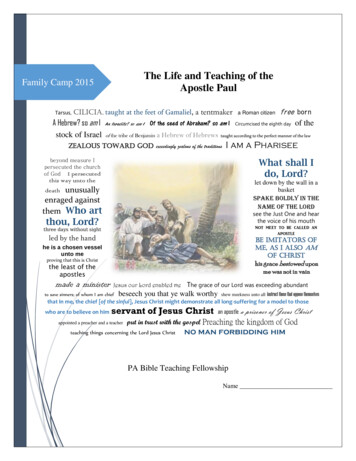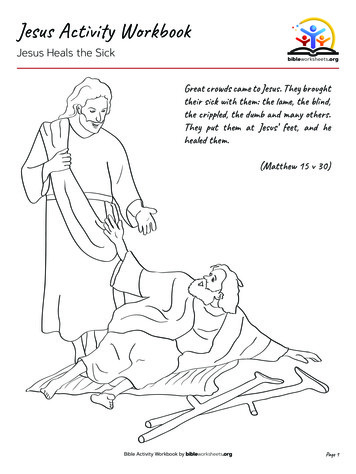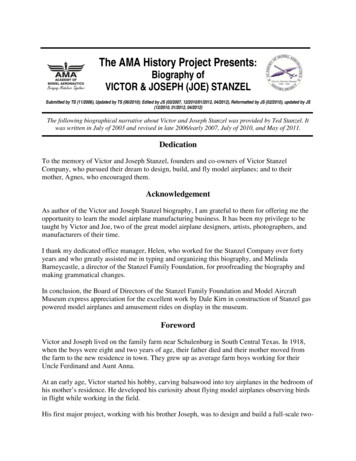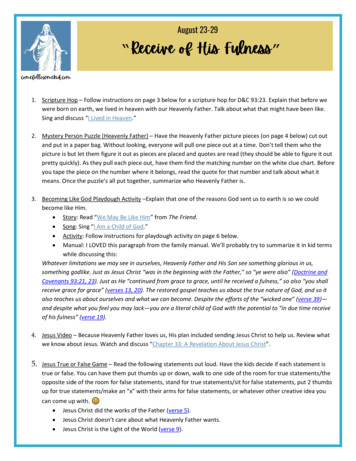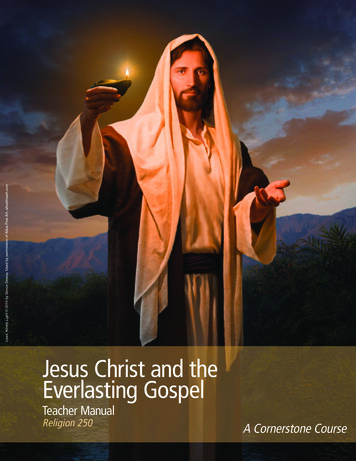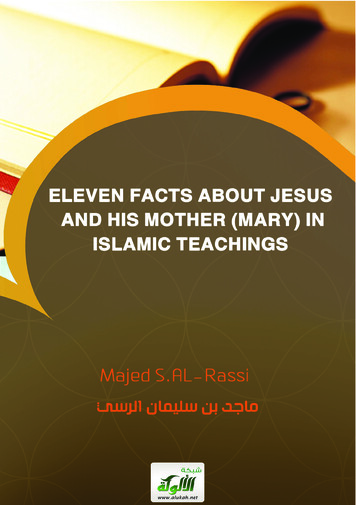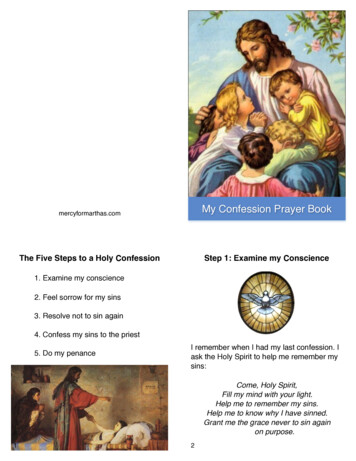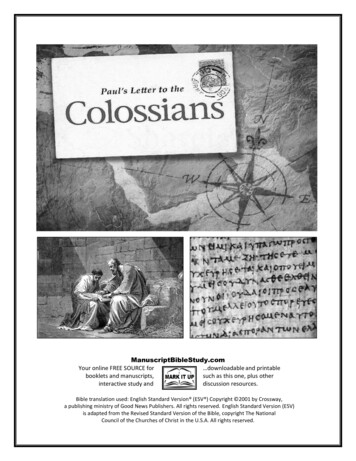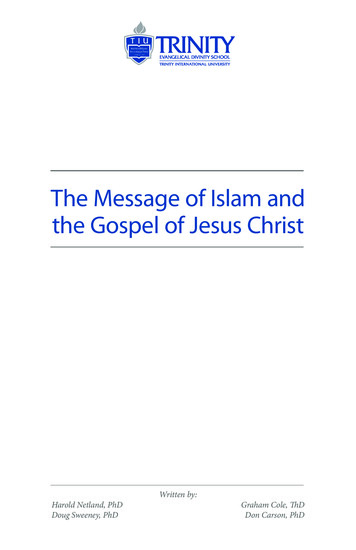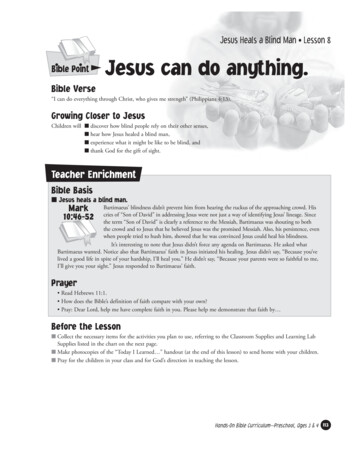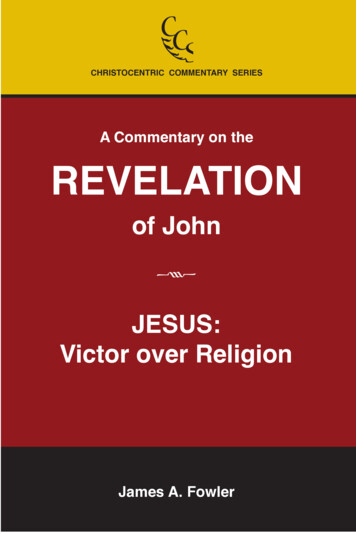
Transcription
CHRISTOCENTRIC COMMENTARY SERIESA Commentary on theREVELATIONof JohnkJESUS:Victor over ReligionJames A. Fowler
CHRISTOCENTRIC COMMENTARY SERIESA COMMENTARY ON THEREVELATIONOF JOHNkJesus Christ:Victor Over ReligionJames A. FowlerciyPublishingP.O. Box 1822Fallbrook, California 92088-1822
A COMMENTARY ON THE REVELATIONOF JOHNkJesus Christ:Victor Over Religion Christocentric Commentary Series Copyright 2013 by James A. FowlerISBN-10 – 1-929541-49-XISBN-13 – 978-1-929541-49-2All rights reserved. No part of this publication may be reproduced, storedin a retrieval system, or transmitted in any form or by any means (including photocopyings, recording, electronic transmission) without the priorwritten permission of the author, except for brief quotations embodiedin critical articles or book reviews. For information contact the author atC.I.Y. Publishing.Published by C.I.Y. PublishingP.O. Box 1822Fallbrook, California 92088-1822Printed in the United States of AmericaScriptural quotations are primarily original translations from the Greektext of the New Testament, but otherwise from the New American Standard Bible, copyrights 1960, 1962, 1963, 1968, 1971, 1972, 1973, 1975,1977, 1995 by the Lockman Foundation, LaHabra, California.
CHRISTOCENTRIC COMMENTARY SERIESCognizant that there are a plethora of New Testament Commentary series available on the market, the question mightlegitimately be asked, “Why another series of New Testamentcommentaries?” Although many capable commentators withvarying theological perspectives have exegeted the text ofthe New Testament over the years, seldom do they bring withthem into their studies a Christocentric understanding that theChristian gospel is solely comprised and singularly centeredin the Person of the risen and living Lord Jesus Christ. TheChristocentric Commentary Series will exegete and commenton the text of the New Testament from the perspective that thetotality of what Jesus came to bring to the world of mankind isHimself – nothing more, nothing less. Having historically diedon the cross and risen from the dead, He is not confined to theparameters of the “Historical Jesus,” but as the Spirit of ChristHe continues to live as He spiritually indwells those who arereceptive to Him by faith. This recognition of the contemporary experiential dynamic of Christ’s life in the Christian willform the distinctive of the Christocentric Commentary Series,bearing out Paul’s Christ-centered declaration, “I have beencrucified with Christ; it is no longer I who live, but Christ livesin me; and the life I now live in the flesh I live by faith in theSon of God, who loved me and gave Himself up for me” (Gal.2:20).
All legitimate exegesis of the scriptures must pay closeattention to the context in which the texts were originally written. The historical context of a text’s sitz im leben, the “settingin life” of the author and recipients, is particularly important,for otherwise the interpretation will simply read into the textthe presuppositions of the commentator and become eisegesisinstead of exegesis. The CCS will carefully consider the historical context as well as the textual context of the scriptures.Whereas the CCS is not intended to be a devotional commentary series or a detailed technical commentary citing allcontemporary scholarship, our intent is to steer a middle coursethat maintains non-technical explanation that is academicallyviable. Although reference will be made to words from theHebrew and Greek languages, those words will be converted toRoman lettering, allowing those who do not know the originallanguages to pronounce them. Citations, quotations, and endnotes will be kept to a minimum.A diversity of interpretive formats will be utilized in theCCS. Some volumes will employ a verse-by-verse exegeticalformat (cf. Hebrews and Galatians), whereas others will provide comment on contextual passages (cf. The Four Gospelsand Revelation). Regardless of the interpretive format, the CCSwill render a “literal interpretation” of the scripture text, that is,in accord with the intended literary genre of the author.As most biblical commentaries are utilized by pastorsand teachers, or studious Christians seeking to understand thescriptures in depth in order to share with others, we join theApostle Paul in the desire to “entrust these to faithful men (andwomen) who will be able to teach others also” (II Tim. 2:2). Inso doing, may you “do all to the glory of God” (I Cor. 10:31).
PREFACEWhen one announces they are going to teach on the bookof Revelation there are generally at least three different reactions to such an announcement. (1) Oh no – it is mysteriouslyconfusing, an enigma, a bewildering riddle which no one canunderstand, so why bother. (2) Oh yes – it is extremely fascinating. These are often the “prophecy freaks” who make ittheir hobby-horse to engage in fanciful speculations. Theybring out their charts, maps, outlines, and study Bibles withextensive notes. (3) Oh no – it is boringly irrelevant. What Ineed is realism; I need to know how to deal with the present,not fly off into the realm of futuristic science-fiction.These reactions can be summed up as: (1) avoidance, (2)preoccupation, or (3) apathy. In this document we want todemonstrate that the Revelation is understandable – so weshould not avoid it; down-to-earth, and presently practical –so we do not have to get involved in fanciful speculation; andrealistic and relevant – so we should not be apathetic about it.Our reaction to the study of Revelation should be: (4) Let ussee what God’s Spirit has to teach us about Jesus Christ fromthis portion of His inspired Scripture.I admit that I avoided the Revelation of John for approximately twenty-five years of my pastoral ministry. Then, in1993, when I began to select a subject for a doctoral dissertation in Biblical Theology, I determined to face down thenemesis of the last book of the New Testament in order towrite a thesis on John’s Apocalypse. Though not a traditional verse-by-verse commentary, the objective was to providea consistent interpretation of the composite of images in theRevelation.
Consistency is a vital interpretive criteria for the understanding of any document of literature. The internal consistency ofallowing every portion of the Revelation to be directed at a unified theme is essential. Consistency with the entirety of the newcovenant literature of the New Testament is equally important.External consistency of Christian interpretation of the Revelation throughout the centuries of Christian thought appears to behopelessly impossible. Or is it? In perusing the wide variety ofinterpretations that have been proffered of John’s Revelation,there does seem to be a common thread. The preterist interpreters have identified the primary images of the Revelation (suchas the beasts, Babylon, and the whore) with the first centuryDea Roma, the religious worship of the Roman Empire andemperor, especially Nero. The historicist interpretations havegenerally sought to identify to identify those same images withthe papacy of the Roman Catholic church, or to a lesser degreewith the religion of Mohammedanism (Islam). Futurist interpretations of the same images have varied widely, but haveoften pointed to a revival of the Roman Empire, a “new worldorder,” or a yet to arise politico-religious personage or power.What is the common thread in these far-ranging interpretations? They all seem to point to religious phenomena. Perhapsthere is a degree of consistency in the external interpretation ofthe Revelation throughout Christian history. With that in mind,this study will take the theme of “religion” as the antagonistand adversary of Jesus Christ throughout the apocalyptic imagery of the Revelation.Our ultimate focus, however, must be on the Victor overreligion, the living Person of Jesus Christ. John explained thatwhat he observed was “the revelation of Jesus Christ” (1:1).May we ever “fix our eyes on Jesus” (Heb. 12:2) as we exegetethe inspired scriptures, and particularly this Revelation.James A. Fowler (2013)6
TABLE OF CONTENTSIntroduction to the Revelation. 1Prologue of the Revelation. 25Religion and the Churches. 57Religion and the Church at Ephesus. 69Religion and the Church at Smyrna. 79Religion and the Church at Pergamum. 91Religion and the Church at Thyatira. 99Religion and the Church at Sardis. 111Religion and the Church at Philadelphia. 121Religion and the Church at Laodicea. 135Religion and the Seals. 147Religion and the Trumpets. 181Religion and the Beasts. 203Religion and Babylon. 233Religion Goes to Hell. 263Epilogue. 297Application. 309Addenda. 315Bibliography. 3257
IntroductionIntroductionto the RevelationThe last book of the Bible is the climactic revelation of howChristianity, i.e. the dynamic of the living Christ, is superior toand triumphant over all religion. In a conclusive climax withculminating clarity, the book of Revelation reveals that Christianity is not religion. Instead, Christianity is Jesus Christ whohas won the victory over Satan, and presently reigns in Hisspiritual kingdom, and will ultimately expose and dethrone allreligious pretenders inspired by Satan when the victory is consummated and made evident to all upon His return.Throughout the entirety of the new covenant literature, theNew Testament, there is a continuing exposure of the radicaldifference between religion and the dynamic life of Jesus Christas it functions within the kingdom of grace. Revelation is theclimactic “capstone” that illustrates the triumph of Jesus overdiabolic religion.Throughout the gospel narratives Jesus is constantly countering the religionism of the scribes, Pharisees and Saducees. Inthe parables Jesus explains that the kingdom He came to bringis entirely different than that anticipated by Jewish religion; Hisis a kingdom that is not of this world and functions by God’sgrace. The religious leaders finally realized that Jesus was exposing them in every parable He told (Matt. 21:45).1
IntroductionThe Acts of the Apostles records the early history of howChristianity was “breaking free from religion,” so as to be unhindered by any identification with Judaic religion.In Paul’s letters it is evident that he saw clearly the dichotomy between religion and Christianity. To the Romans Paulexplains that righteousness is not in religious rites or the Law,but in Jesus Christ, the Righteous One. In the first epistle to theCorinthians Paul counters the religious excesses that were developing in the young church in Corinth. In the second epistleto the Corinthians Paul differentiates between gospel ministryby the grace of God and the manipulations of religious method.The letter to the Galatians forcefully denies that there is “another gospel” as inculcated by legalistic religion. The gospel isJesus Christ alone functioning by grace. Writing to the Ephesians Paul contrasts religious exclusivism with the universalityof the Christian gospel and explains that in Jesus Christ all menbecome a new humanity. In his correspondence with the Colossians Paul combats the effects of the regional religionism ofAsia, emphasizing the preeminence of Jesus Christ who is thelife of every Christian individual.The writer to the Hebrews explains how the old and the newcovenants are differentiated. The old tenets of Judaic religionare replaced by the life of Jesus Christ. James explains thatif one is just going through the rituals, such religion is vain.Christian faith is the outworking of the life of Jesus Christ.Finally, then, in the Revelation, John relates in pictorial storyform that religion will try to overcome and secularize Christianity, but Jesus Christ overcomes all the machinations ofreligion by His life.For many years preachers, teachers and commentators havebantered and battled, bickered and babbled about what Revelation means. After immersing myself in the new covenant2
Introductionliterature of the New Testament for many years, I have come torealize that the Revelation is consistent with the rest of the NewTestament in declaring that Christianity is not religion. Christianity is to be contrasted with religion. Christianity is in conflictwith religion. This is particularly apparent in the Revelation,where Jesus Christ is portrayed as the victor over all religion.It is usually conceded that this epistolary, apocalyptic book ofprophecy was written late in the first century, probably around95 AD. Of late there have been attempts to explain that thebook was written prior to 70 AD, but this is usually an attemptby certain post-millennialists to justify their preterist interpretation, and their setting of the book in a politically persecutivecontext. The external evidence of early church writers seemsto sufficiently document that the book was written late in thefirst century. Irenaeus (c. 180 A.D.), for example, indicatedthat John saw his vision “almost in our day, toward the end ofDomitian’s reign.” Domitian was the Roman emperor from 8196 A.D. Despite when it was written; the message is the same,but the historical context of any document is important for itaccurate interpretation. The date toward the end of the firstcentury does seem to allow for the perverting and “religionizing” of the churches of Asia, to which the letter is addressed,but “religion” had long plagued the churches of this region.Paul combated “religion” in Ephesus and decided it was best todepart (Acts 19:1-20:1); he cautioned the Ephesian elders about“religionizers” from without and within the church (Acts 20:2831). In writing to the Colossians, he warns about “man-madereligion” (Col. 2:20:23). We will assume that this commentarywas drafted toward the end of the first century.We will also assume that it was written by the apostle John.The author identifies himself as “John” four different timesin the book (Rev. 1:1,4,9; 22:8). The best known “John,” whowould not need to give any other clarification of his identity,3
Introductionwould have been the apostle John. The earliest Christian writers accepted the apostle John to be the author.It has been pointed out that the grammar and vocabulary ofthe Greek text in which this book is written is very rough andcoarse, with what one author called “barbarous idioms.” Johnwould have flunked Greek Grammar 101. John’s writing in thegospel and the epistles is quite polished, however. Is it becausehe was getting elderly? He was probably old when he wrote thegospel and epistles, also. Is it because he didn’t have a secretary, an amanuensis, out on the island of Patmos, as he seemsto have had when he wrote the epistles? Or is it because thevision was so overwhelming and going on all around him, andhe was just writing as fast as he could, not worrying about hisgrammar?Despite the fact that the Greek grammar is different from thegospel and epistles, and that there are concepts in Revelationnot found elsewhere, there are many similarities which tieRevelation with the other Johannine writings: For example,the use of the word logos - John 1:1,14; I John 1:1; Rev. 19:13;Jesus as “lamb” - John 1:29,36, 28 times in Rev.; Christ asbridegroom - John 3:29, Rev. 19:7; 21:2; 22:7; Jesus “pierced”- John 19:34, Rev. 1:7; Jesus’ overcoming - John 16:33, 6 timesin I John, 17 times in Revelation.Picture-languageThe first word in the Greek text of this book is the Greekword apokalupsis. Thus it is that the book is often referred toas the Apocalypse. It is often explained that this writing is anexample of Jewish apocalyptic literature that was prevalent inthe last couple of centuries before Christ and in the first centuryA.D. Many of the academic attempts to narrowly define apocalyptic literature as distinct from parables, prophecy and allego4
Introductionry are “forced” categorizations. It is better to recognize that itwas typical Middle-eastern thinking to teach by “story-telling”in picture-language.It might be argued that the Revelation is the big, multi-faceted, new covenant parable! A good prelude to studying Revelation would be to study the parables of Jesus, which are theprevious picture-language story-telling of Jesus Christ utilizingimages and symbols. A study of the parables in the gospelswill reveal that Jesus used them as an exposé and critique ofreligion, in order to explain the difference in the new covenantreality of His life functioning in grace within the kingdom.1Jesus uses picture-language in the Revelation in much the sameway as He did in the parables.Just as in the parables, we should not try to force a fullfledged allegorical understanding upon the images. We shouldnot try to figure out the meaning of every detail. The “literalist”who demands a “direct face-value” for every detail in the bookis approaching Revelation like a “mechanic” tightening everynut and bolt, rather than an “artist” who wants to “see” the BigPicture. We do not have to get every detail figured out, naileddown. That is the absolutism of understanding that “religion”tries to achieve. Jesus wanted us to think, to ponder, to be discerning; that is why He spoke in parables and picture-language!If Jesus had wanted theological precision or the precision ofprophetic calculation, He would have used a different methodof teaching, and a precise vocabulary. He would have usedplain, straight-foward language!John was apparently an individual with an artist-mentality.He was a picture-painter with words. He often conveys what hewants to say with images and analogies. In the gospel that hewrote he employs pictorial language: Jesus is the “light of theworld” - in contrast to which religion is darkness and blindness5
Introduction(8,12). Jesus is the “good shepherd” - in contrast to the hirelings of religion (15). In his epistles (I,II,III John) he continuesto use images of “sons of light” and “sons of darkness;” sons ofGod and sons of the devil. He saw clearly the either/or antithesis of God and Satan, and pictured such in many ways. Whenhe writes what he saw in the Revelation, it is predominantlypicture-language.John saw the Big Picture and painted it in word-pictures. It islike a cosmic canvas on which he paints. He paints from God’sperspective, and it is difficult for us to get far enough back tosee the whole picture. We tend to analyze the strokes and thetexture. When we come to the book of Revelation, it is so easyto miss the forest for the trees; to miss the message for theminutia of detail and the fanciful interpretation of those details.We do not have to figure out every detail. If any man could dothat, he could stack all the factual data of interpretation andput it on the “knowledge” shelf. That is part of the “epistemological heresy” of religion, that reduces Christianity to a mere“belief-system.” The life of Jesus Christ cannot be formulizedand “put in the box” of doctrinal or eschatological understanding. Who would want such “canned” Christianity? Who wouldwant such a rigid rectification of Revelation?Therefore, we should attempt to see the message of Revelation in broad sections, rather than analyzing every detail; amacro-vision, rather than micro-vision.The structure of this recorded vision seems to be somethinglike a “movie in the round.” Have you ever been to one ofthose movies where multiple camera angles recorded the actionon every side, 360 degrees around you? When the action starts,you can hardly keep your equilibrium. We do not have eyesin the back of our head, so we cannot see everything at once.To see the whole movie, you would have to re-run it several6
Introductiontimes and see the different perspectives. The Revelation-visionseems to be like that. John “runs it by again” to view the newcovenant reality of Jesus Christ from different perspectives. Heturns the gem around to look at different facets of its brilliance.The Revelation is not so much a time and space, chronological sequence of either history or the future, but is an increasingly intensified recapitulation of the new covenant reality of JesusChrist. In repetitive parallels John views Jesus from differentperspectives, different angles, another picture, another view. Itdoes not seem to be consecutive or contiguous, but rather concyclic or synchronous – the Big Picture in the round!I will never forget the occasion when I was talking to a youngman who was zealous to understand the Bible and spiritualthings. He was not well-versed in theological vocabulary, butwas trying to use some of the terminology. In referring to thebook of Revelation, he meant to refer to it as “apocalyptic,” butinadvertently transferred the vowel sounds, and instead referredto it as “a-pickle-optic.” I could not help but chuckle to myselfwhen he said it, and the more I thought about it the funnier itbecame, because I realized that “a-pickle-optic” could be usedto describe “apocalyptic.” The pictorial imagery that John sawin the vision can indeed be “a pickle of an optic.” The interpretation of the symbols has proved to be a difficult “pickle” forBiblical commentators for almost two millennia.Though the book of Revelation can be “a-pickle-optic,” itwas meant to be apocalyptic. As previously noted, the book isoften identified as the Apocalypse, which is a transliterationof the first word in the Greek text of this book, apokalupsis.Apokalupsis is derived from two other Greek words, apo from, and kalupto to cover or hide. The Greek word apokalupsis meant to uncover, unveil, disclose or reveal. Thus it isthat we usually refer to this book in English as the Revelation.7
IntroductionThe purpose of this book was not to provide a difficult puzzleof images for future expositors to sort out, “a-pickle-optic,” butrather to reveal, through the Middle Eastern method of storytelling, the triumph of Jesus Christ.Varying InterpretationsIt will be instructive to consider some of the varying interpretations of Revelation and the interpretive methods they employ.There are hundreds, if not thousands, of varying interpretationsof the Revelation, but some of the broader schools of interpretation might be identified as follows: (cf. chart in Addendum E)(1) Preterist interpretation. This label is derived from theLatin word praeter, meaning “past.” This interpretation viewsthe pictures of Revelation as referring to what was happeningin the past, in the first century. They see the images as representing governmental persecution during the reign of eitherNero or Domitian. Most understand Revelation chapters 21 and22 as referring to the future, but there are some who “spiritualize” and put all 22 chapters of Revelation back in the past ofthe first century.(2) Historicist interpretation. This interpretation stretches outthe images of Revelation to refer to the history of the Westernchurch. For example, the “fifth trumpet” has been interpreted asthe Mohammedans in the 7th century; the “sixth trumpet” hasbeen viewed as the invasion of the Turks. Chapter 10 allegedlyrefers to the “strong angel” who announces the Protestant Reformation when the “little book” was found, i.e. the Bible. The“seven thunders” are against the Pope. Revelation 11 and themeasuring of the temple is interpreted as the Reformation determination of the true church, and the two witnesses have beeninterpreted as Luther and Calvin against Rome. The ultimatevictory is the overthrow of the Roman papacy.8
Introduction(3) Futurist interpretation. Revelation 1-3 is recognized to bein the past, but chapters 4-22 are regarded as the record of future events in the seven-year tribulation, leading to the secondcoming and the millennium. Ryrie, for example, takes 1:19 asthe structural “key” for Revelation: (1) “things seen” - 1:9-20(2) “things which are” - 2:1-3:22 (3) “things which shall takeplace” (4:1-19:21 in the tribulation; 20:1-15 in the millennium,etc.)(4) Triumphalist interpretation. Sometimes called the idealistor symbolic interpretation, this interpretation usually sees theimages of Revelation as explaining the conflict of good andevil, God and Satan, throughout all of time.The preterist commentator interprets the message of Revelation primarily as in the past. The historicist interprets the message of Revelation primarily as the process of Western history.The futurist interprets the message of Revelation as referringprimarily to the future. The triumphalist interprets the messageof Revelation primarily as the symbolic representation of thetriumph of Jesus Christ in every age.These varying interpretations are not necessarily issues tofight over. There is value in each of them. From the preteristwe can learn that Christianity is contextually rooted in thehistorical past, and so is the Revelation. From the historicistwe can learn that Christianity is continually timely, and so isthe Revelation. From the Futurist we can learn that Christianityis confidently hopeful for the future, and so is the Revelation.From the Triumphalist we can learn that Christianity is constantly recognizing Christ’s victory, and the book of Revelationcertainly reveals such.Regardless of which interpretive method one employs, onehas to admit that there is symbolism in Revelation that pictures9
Introductionthe triumph of Christ; the letter was first written to historicalchurches in Asia in the past, back in the first century; it is arevelation that has had some message for Christians throughouthistory; and Revelation does speak of the ultimate victory ofChrist at the end of time in the future.In this study we will employ a Christocentic or Christological interpretation that would probably be a sub-category of theTriumphalist or Symbolic interpretation.The reason I employ the Christocentric-Triumphalist interpretation of Revelation is because it seems to me to provide thebest consistency with the interpretation of the rest of the Scriptures. The Bible is consistent in its message from beginning toend, and the Bible is the best commentary on the Bible. Theconsistency of this interpretation is seen from its:(1) Scriptural consistency. The whole of the revelation ofScripture is to reveal that Jesus Christ is the divine life thatmakes man man as God intends. Religion will not suffice. The“tree of the knowledge of good and evil” can be viewed as the“religion” tree; the “tree of life” as Christianity. The naturaltendency of man is to revert to “religion” man-made religion.”(Col. 2:21).There is a consistency in this interpretation with the Old Testament prophets. They were critiquing “religion” and callingfor repentance, using some of the same images.There is a consistency in the use of picture-language andstory-telling. God uses pictures. The entire Old Testament canbe viewed as the “picture-book” illustrating what God was todo in Jesus Christ.10
Introduction(2) New Testament consistency. The entirety of the new covenant literature, the New Testament, explains the superiority ofChristianity over all “religion.” Christianity is not religion, it isthe vital dynamic of the life of Jesus Christ lived by grace.The New Testament concept of “prophecy” is primarily thatof proclamation rather than prediction; forth-telling rather thanforetelling. The prophecy of Revelation is likewise a proclamation of Jesus Christ, rather than the future.(3) Internal consistency. The preterist and futurist interpretations seem to segment the interpretation of Revelation, some inthe past, some in the future, with a big chasm in-between in thepresent. This tends to divide the Revelation into “revelations,”as many people inaccurately refer to this book, and create adisjuncture. The Christocentric-Triumphalist interpretation thatexplains the conflict between Christianity and religion, allowsthe entire book to remain consistently connected. Chapters 2and 3 provide the historical setting of “religion” creeping intothe churches, so that chapters 4-22 can be pictorially placedalongside to reveal the conflict between Christianity and religion.It is extremely important that we approach the Revelation,willing to engage in exegesis, rather than eisegesis. What is thedifference? Exegesis comes from two Greek words meaning“to lead out.” It means that we derive the meaning “out of thetext.” We do not want to “read into the text” our preconceivedideologies and interpretations. That is eisegesis. Too often people come to the book of Revelation with predetermined eschatological opinions, ideological “grids,” and they use and abusethe book to try to document what they think they already know,twisting it to fit their presuppositions.11
IntroductionSome try to make an issue between “literal” interpretationand “symbolic” interpretation. “Literal” does not mean just adirect, face-value interpretation of the words. “Literal” interpretation refers to an interpretation that is in accord with theliterary style and literary intent of the author. If the literatureis written in a literary style that uses images and symbols, then“symbolic” interpretation is “literal” interpretation, i.e. it is aninterpretation that is consistent with the literary genre of
A Commentary on the REVELATION of John JESUS: Victor over Religion James A. Fowler k. CHRISTOCENTRIC COMMENTARY SERIES A COMMENTARY ON THE REVELATION OF JOHN Jesus Christ: Victor Over Religion James A. Fowler Publishing P.O. bOx 1822 FallbrOOk, CaliFOrnia 92088-1822 k ciy. A
